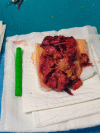Campylobacter jejuni subdural hygroma infection in a 2-year old boy: case report and a brief literature review
- PMID: 35987621
- PMCID: PMC9392325
- DOI: 10.1186/s12879-022-07680-0
Campylobacter jejuni subdural hygroma infection in a 2-year old boy: case report and a brief literature review
Abstract
Background: Campylobacter jejuni is a common cause of acute gastroenteritis, but central nervous system infections are rare manifestations of Campylobacter infection. Therefore, C. jejuni trauma-related subdural hygroma infection in children is poorly described in the literature.
Case presentation: We described a 2-year old boy with lobar holoprosencephaly presenting with subdural hygroma following head trauma. C. jejuni infection was confirmed from a subdural hygroma sample by culture as well as by DNA sequencing of a broad range 16S rDNA PCR product. Cerebrospinal fluid from the ventriculoperitoneal shunt remained sterile. Combined neurosurgical and antimicrobial treatment led to complete recovery. Review of the literature showed that the most common manifestation of Campylobacter central nervous system infection is meningitis, mostly in neonates, and subdural hygroma infection was described for only one case.
Conclusions: Subdural hygroma infection caused by C. jejuni is a rare clinical condition in children. Molecular methods represent an important tool for the detection of rare or unexpected pathogens. No standard recommendations for antimicrobial treatment of C. jejuni subdural space infection in children are available, but meropenem treatment combined with surgery seems to be an effective approach.
Keywords: 16S rDNA; Campylobacter jejuni; Children; Meningitis; Subdural hygroma.
© 2022. The Author(s).
Conflict of interest statement
The authors have no relevant financial or non-financial interests to disclose.
Figures
References
-
- Bennett JE, Dolin R, Blaser MJ. Mandell, Douglas, And Bennett’s principles and practice of infectious diseases. 9. Philadelphia (PA): Elsevier/Saunders; 2019.
-
- European Centre for Disease Prevention and Control. Campylobacteriosis. In: ECDC. Annual epidemiological report for 2017. Stockholm: ECDC; 2019. https://www.ecdc.europa.eu/en/all-topics-z/campylobacteriosis/surveillan.... Accessed 5 July 2022.
-
- Croatian Institute of Public Health. Croatian Health Statistical Yearbook. https://www.hzjz.hr/sluzba-javno-zdravstvo/hrvatski-zdravstveno-statisti.... Accessed 5 July 2022.
Publication types
MeSH terms
LinkOut - more resources
Full Text Sources
Medical



